Our old-fashioned ice cream maker guide includes helpful tips, like how to choose the best machine (electric or hand crank), how to use your ice cream maker, and homemade ice cream recipes you can make with your machine. We all scream for ice cream!
When it comes to homemade ice cream, I feel like I trained for this moment all my life. I really did have the best teachers on both sides of my family.
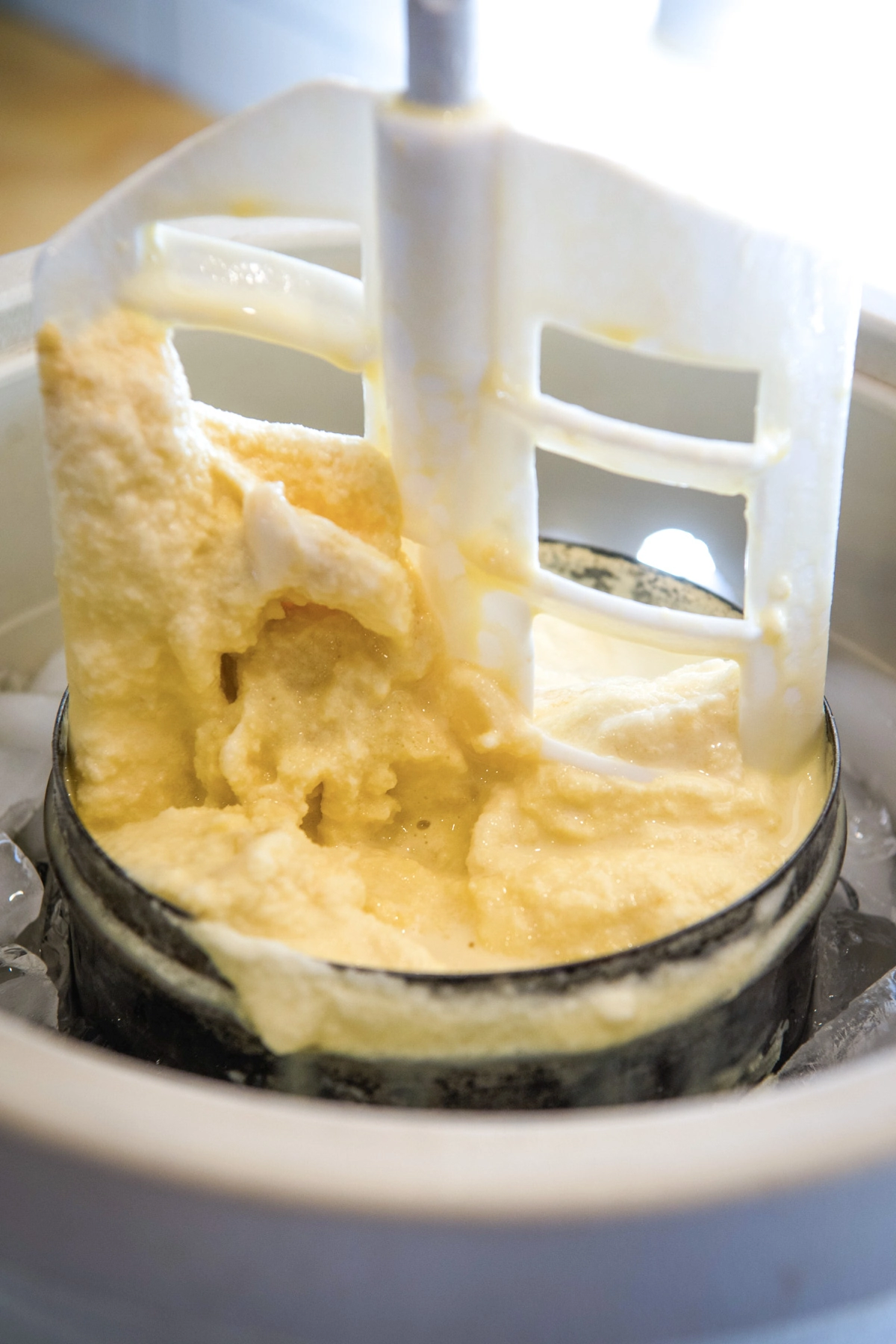
I still remember my grandpa giving me the job of turning the crank on his old ice cream maker. Oh how my arm burned after several turns of that old metal crank.
My mom and dad had an electric ice cream maker, no hand crank necessary. In fact, my family and I now have a very similar machine to what I grew up with, and it makes the best homemade banana ice cream (my absolute favorite flavor).
I talk a lot about ice cream on this here blog, and I've shared many family recipes. So I figure it's high time I give you an actual guide on what to look for when it's time to buy your own ice cream maker.
For the purpose of this guide, I'm going to focus on both old-fashioned electric and hand crank ice cream makers with a churn paddle. You'll also need a mixture of rock salt and crushed ice to properly freeze the ice cream.
You may find this guide to ice cream accessories and tools helpful, as well.
How Does It Work?
As much of a worldwide staple as ice cream has become, isn't it crazy to think that the first hand cranked ice cream maker was invented just 179 years ago by American Nancy Johnson? For more info on the history of ice cream, check out The Extraordinary History of Ice Cream by Dreamscoops.
Between then and now, not much has changed in the way of how an ice cream maker works.
Whether you're cranking by hand or using an electric motor, a vintage ice cream maker always consists of a metal canister that's buried in a combination of ice and rock salt. Rock salt makes the ice cream freeze faster, yielding a much finer, silky smooth texture.
Side Note: The best place to find rock salt is usually a small, local feed store. Of course, crushed ice can be found at just about any grocery store and/or gas station.
Naturally, the edges of this canister are colder because of the surrounding ice bath. As your ice cream maker churns, the paddle inside of this canister scrapes frozen ice cream from the cold edges and into the middle.
At the same time, it always replaces the colder ice cream from the edges with warmer ice cream from the middle, freezing whatever it touches. The goal is to gradually freeze all the contents of the canister as it churns the mixture again and again.
Eventually, the mixture will start to resemble the ice cream we all know and love. That means it's almost time to eat!
How to Make Ice Cream with an Old Maker
As always, ensure that your ice cream freezer is clean. We store ours in the garage (or sometimes the attic) between uses, so we always have to wash it before making ice cream.
While it's not needed, I highly recommend some sort of electric mixer to mix up your ice cream. You can use a stand-up mixer, or you can even use a small hand mixer. In fact, my dad used a blender to make some of his best ice cream!
Although I will advise you to follow the manual or manufacturer instructions for your specific ice cream maker, here's how I freeze ice cream…
- Pour the ice cream mixture into the metal canister of your ice cream maker.
- Then top it off with whole milk to the fill line. That's usually about 3/4 of the way full. It's important that you leave plenty of room for expansion as it freezes.
- Put the lid on, and place the canister down into the bucket of your ice cream maker.

- Attach the motor to your ice cream maker; whenever you're ready, plug it in to start the freezing process. Once plugged in, it should start churning.
- Gradually pour crushed ice around the canister as it turns.
- Alternate adding crushed ice with rock salt. You'll want to add 2-3 cups of rock salt in total, beginning with the crushed ice and ending with rock salt.
- As it churns, keep an eye on the motor. If it starts to seize up at all, it may be necessary to add some cold water. You may also need to add more ice and rock salt as the ice cream freezes. As with the water, don't add too much– just enough to keep everything in line.
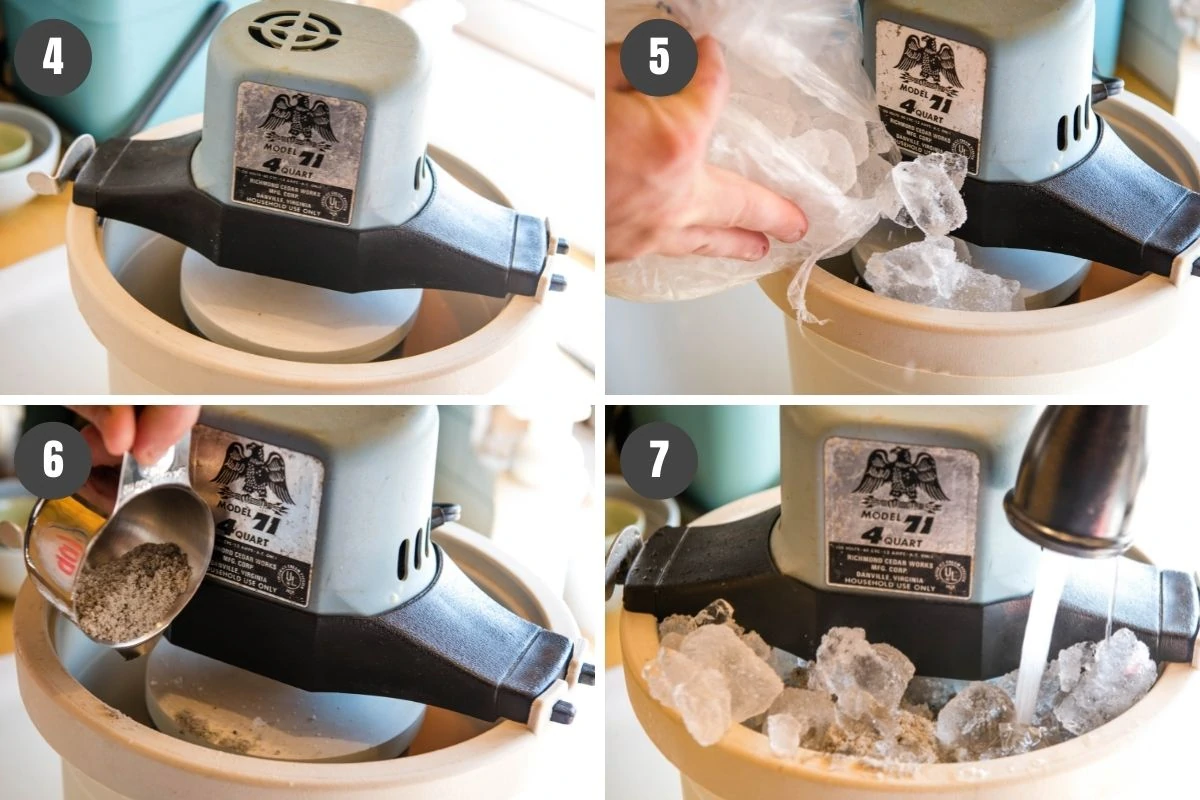
How long does an old-fashioned ice cream maker take?
It can take 30-45 minutes for ice cream to freeze. That said, it's always best to play it by ear.
When the motor stops, that means the ice cream is frozen, and you need to unplug your machine immediately. At this point, you can wipe any excess ice or salt off the lid, remove the lid, pull out the churn paddle (and decide who gets it), and scoop your ice cream into bowls for serving.
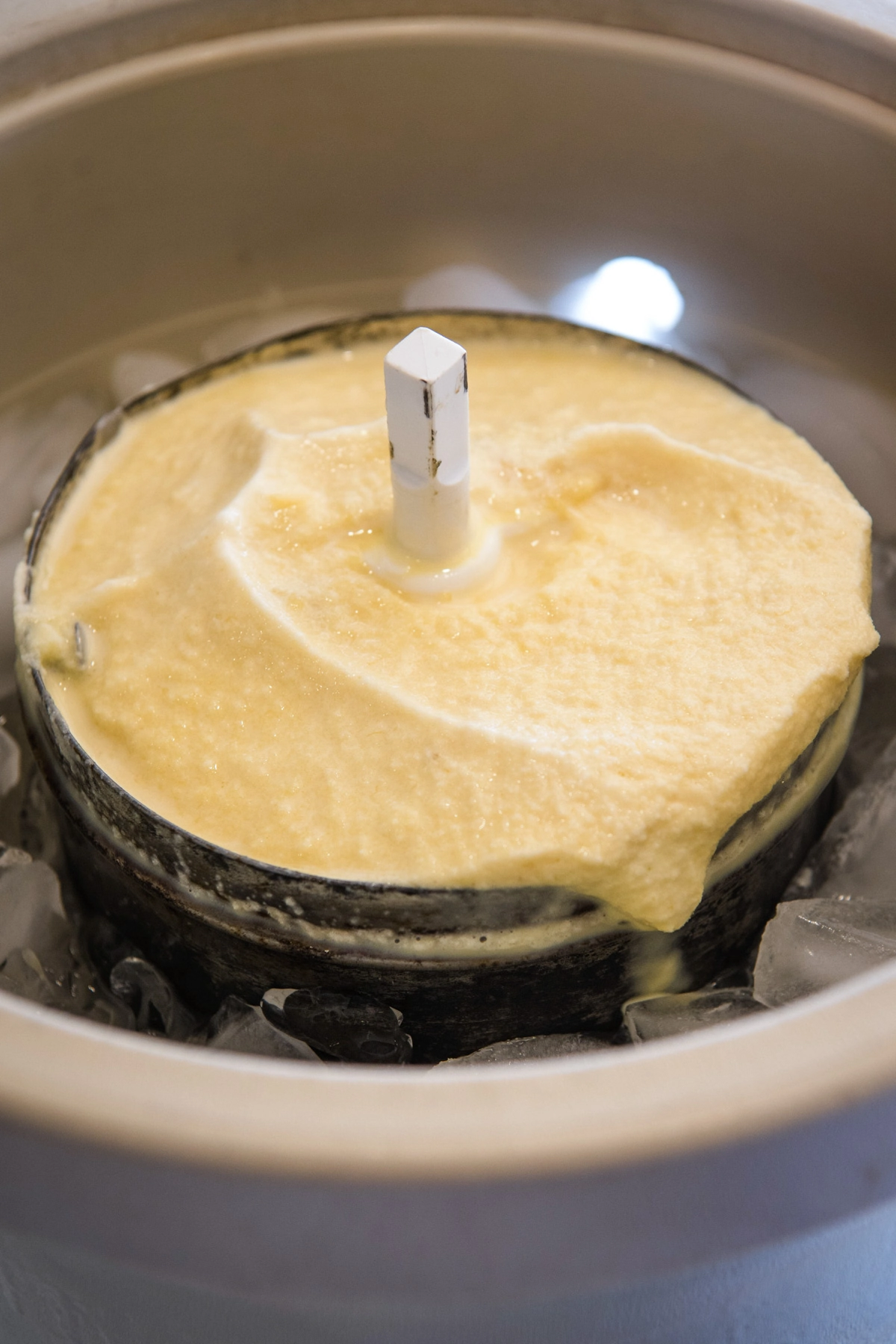
As you can see, if you decide to use a hand crank ice cream maker, you'll have quite the workout!
Things to Consider Before Buying a Machine
An ice cream maker can be an investment, so it's wise to think about a few things before making that purchase.
- You can get a hand crank ice cream freezer, or you can get one with an electric motor. Hand crank makers are not usually any cheaper, and they require way more time and attention than an electric ice cream maker.
- Ice cream makers come in all different shapes and sizes. It's important to consider how often you'll make ice cream, as well as how large a batch you'll want to make. You can get small (1 quart, personal-sized capacity), medium (1-2 quart capacity), and large (2-4+ quart capacity) ice cream makers.
- We found that a 4-quart ice cream maker is best for our needs. Under normal circumstances, that gives our family a large batch of ice cream plus leftovers to freeze for later. Of course, this size also allows us to make large batches to take to events, ice cream socials, and get-togethers, if needed.
- Some old ice cream makers are noisier than others. If you're sensitive to noise like I am, this is definitely something to consider!
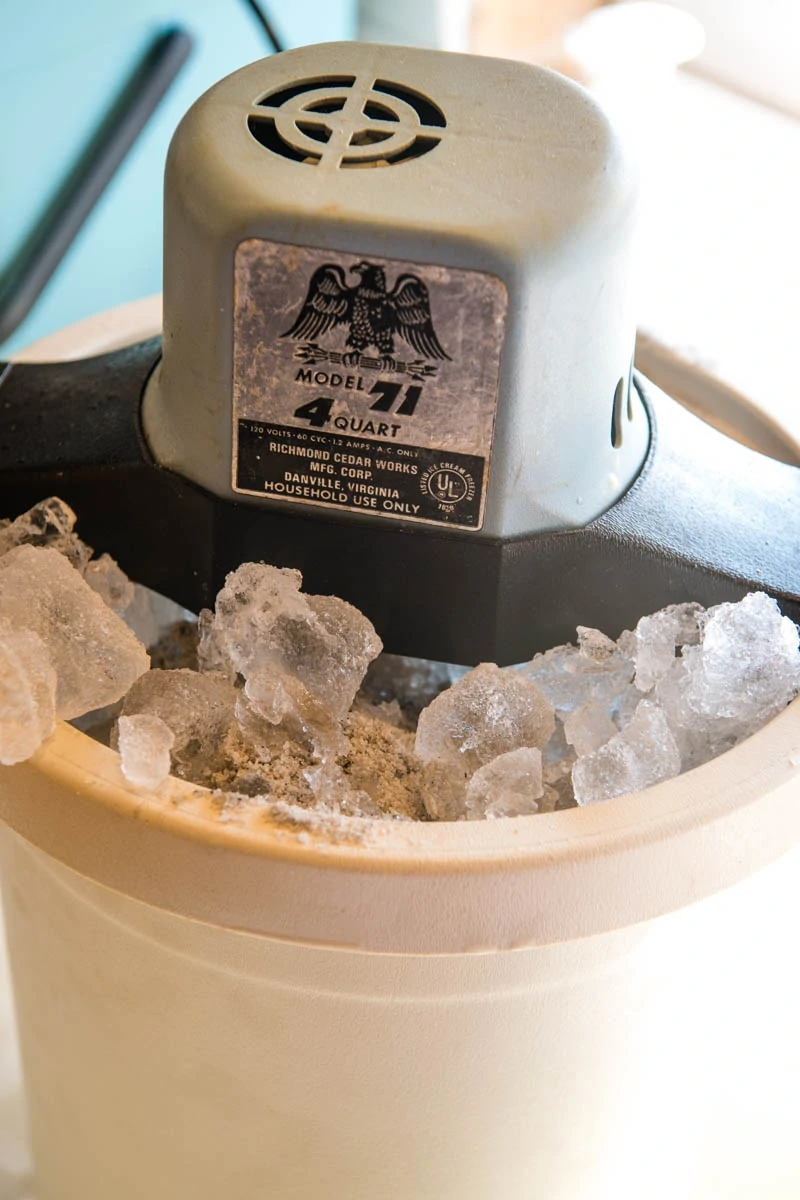
Choose the Best Ice Cream Maker for You
This list includes some of my favorite, most practical ice cream makers on the market right now…
- Richmond Cedar Works Ice Cream Maker Model 71 – This 4-quart ice cream/frozen yogurt freezer (with plastic tub) is actually the ice cream freezer we own and use. We picked ours up several years ago at a yard sale or auction, I can't remember which; but it works wonderfully well. While I haven't been able to find modern day, brand new models of this machine, there are plenty available on eBay, if you're not opposed to buying used. You can also keep your eyes open at yard sales, flea markets, antique stores, and auctions.
- Immergood Stainless Steel Hand Crank Ice Cream Maker – This one features high-quality stainless steel components that are made to last a lifetime. The triple layer construction offers excellent insulation to the central canister for a far more efficient and timely batch of ice cream. This also makes it very unlikely to ever leak or fall apart, provided that it's taken care of properly. It's pricey, but if you're looking for a truly old-fashioned, hand crank ice cream maker with an extra-large, 6-qt capacity, this one's for you!
- Elite Gourmet Old Fashioned Wood Bucket Electric Maker Machine – Here's one with both a hand crank and an electric motor. The handy 120V motor locks right onto the bucket, ensuring a “whisper quiet” operation. It features an easy-cleaning, dishwasher-safe 4-qt aluminum canister that nests inside a beautiful wooden freezer. According to Elite Gourmet, you can just throw your ice cream in the bucket, plug it in, and go– or you can take it slow and hand turn your ice cream just like Grandpa did!
- Nostalgia Electric Bucket Maker – This is the first one on the list without a hand crank option. If cleanup is a concern, this one features a 4-qt plastic bucket that is especially easy to clean. Like the machine from Elite Gourmet, this one has a wooden freezer; it's beautiful! Again, the powerful motor locks into place for safe, quiet operation.
- Elite Gourmet Electric Motorized Ice Cream Maker – This budget-friendly electric ice cream maker is similar to the Elite Gourmet farther up the list, but it features a galvanized bucket rather than wood. It's not as pretty, but it's great if you have trouble with leaks and/or damage to the wood during operation. It has an easy-cleaning plastic liner, and the 4-qt capacity is perfect for most families.
- Hamilton Beach Automatic Ice Cream Maker – This is one of the more affordable electric ice cream makers on the list. Nevertheless, it still has a very sizable 4-qt capacity, and the plastic canister and freezer with an easy-lock lid are fairly easy to clean. It's fully automatic, and it even comes with a few recipes to try! While it's not as nice as some of the other ones listed, it'll get the job done, and it'll do it well.
- Nostalgia Electric Maker with Easy-Carry Handle – At $32, this 4-quart maker is just plain cheap! It features a plastic bucket and canister, and it even has a see-through lid. The convenient handle makes for easy transport, and the little motor locks right into place for safe operation. It's not bad!
Old-Fashioned Ice Cream Maker Recipes:



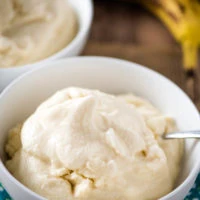
Watch the Whole Process from Start to Finish
CRAVING MORE DELICIOUS RECIPES? Subscribe to my newsletter and follow along on Pinterest, Facebook, YouTube, and Instagram for all the latest updates!


I have the model 71 as well, never given me any trouble in 20 years, but now, the can stops rotating every half revolution before I’ve even put any ice in, and once I’ve put the ice/salt/water in, it keeps doing that and then I have to help it along. Any ideas?
Hey Carrie, is the motor starting to have trouble? Otherwise, I’m not sure really sure what would cause this.
any recipe old fashioned peanut butter ice cream ? most of them included peanut butter cup. i prefer peanut butter cream
I’m actually thinking of working on one, Deborah! I’m in the same boat. I’d like actual peanut butter ice cream, not peanut butter cup. Maybe I’ll have a recipe up one of these days…
lately our ice cream canister, once the ice cream is frozen, is laced with the salty ice water from outside the canister about halfway down after i have begun dishing out the ice cream. it’s literallly a soupy mess of watery, salty puddles in the canister the rest of the way down, so i have to throw away over half the ice cream. our freezer is the first one you described, model 71 from richmond cedarworks. any idea why? we’ve been making ice cream for almost 50 years and never had this problem until the past 6 months. we have had many freezers. the canister does not leak. it’s too expensive an activity to keep making ice cream for our family if i have to throw half of it away. thanks for any ideas you may have.
Patty, it sounds as if your machine is either leaking, or there is too much salt and ice, and it is overflowing in to the ice cream machine. Are you sure it’s not leaking?
Do you have a recipe for homemade chocolate ice cream
Nope, not yet anyways…